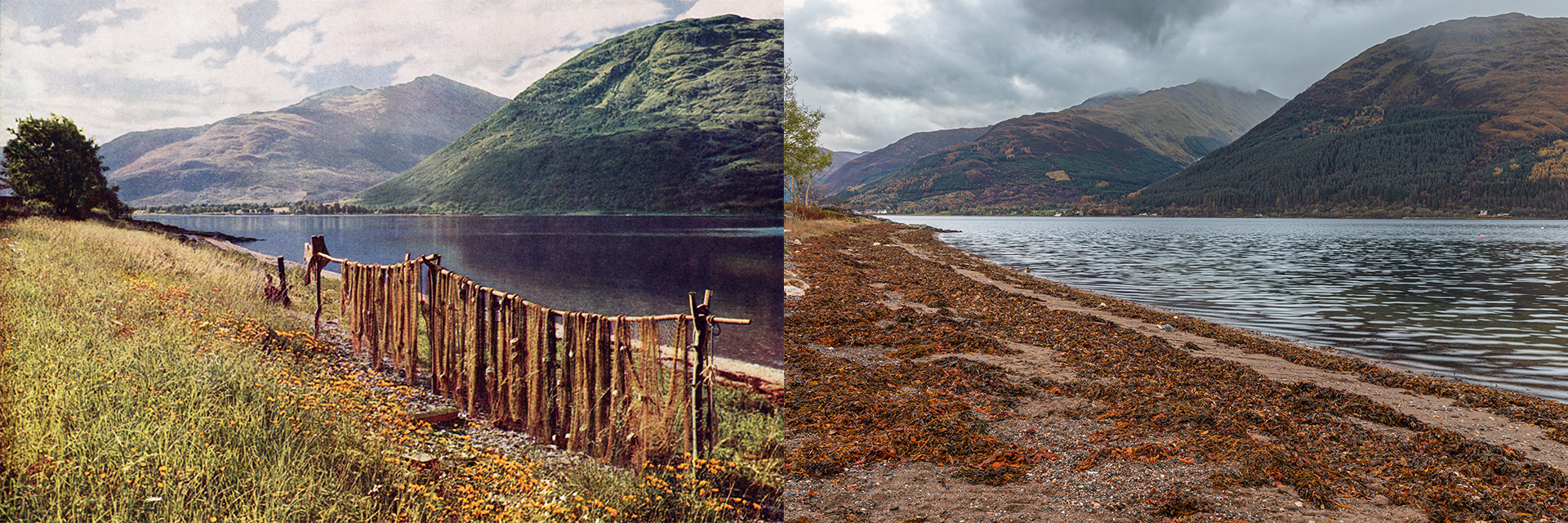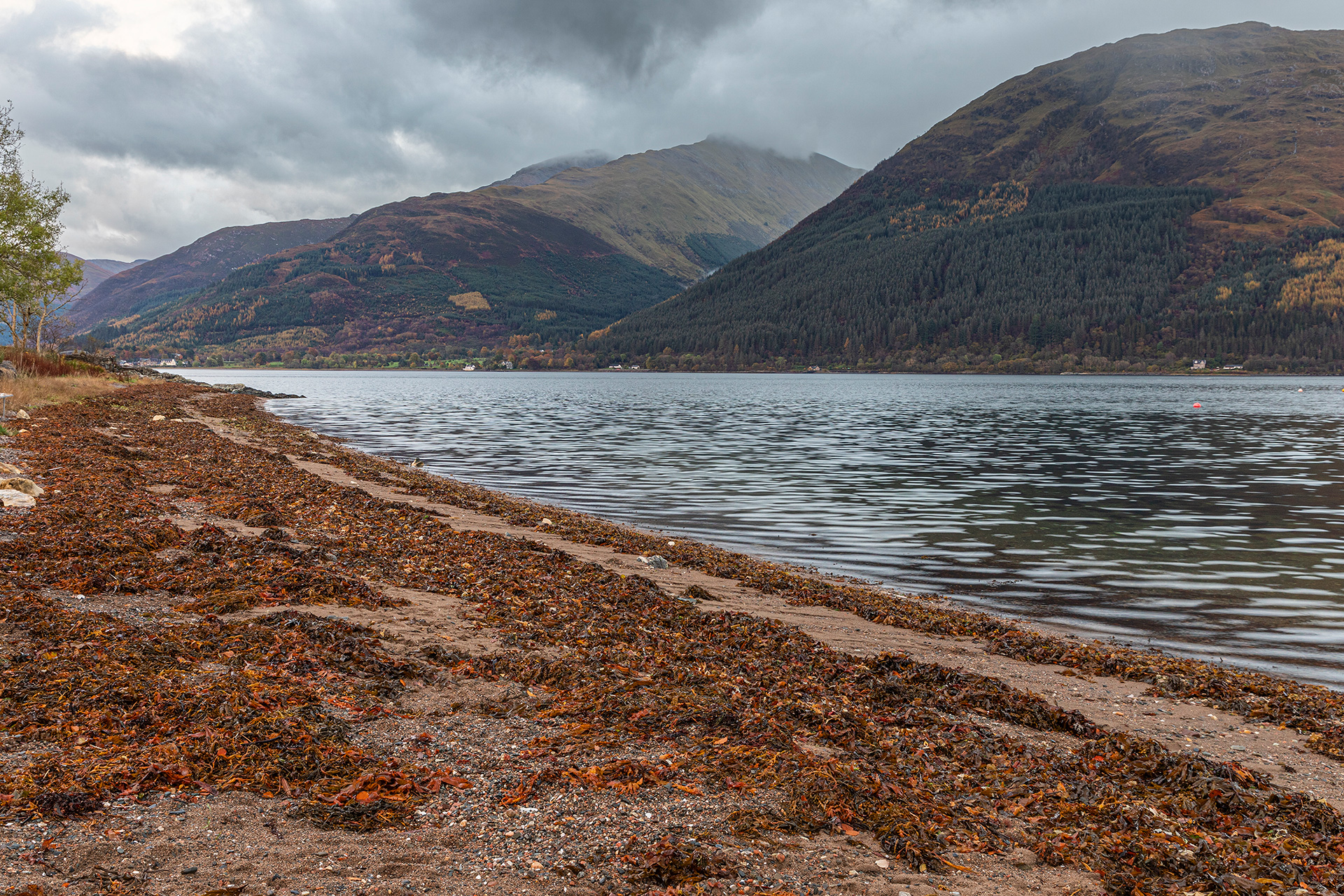For a year, photographer and history researcher Estelle Slegers Helsen has wandered around Lochaber in the footsteps of W.S. Thomson MBE (1906-1967). Estelle has made a series of remakes roughly 70 years after Thomson originally depicted the landscape. She has talked to local people along her journey and now Estelle will be taking you to the different places in Lochaber. This is article #10.
Drying nets at Onich, Loch Linnhe

‘That’s not Loch Leven, but Loch Linnhe,’ says Mairi Kirsop (née Cameron) as she corrects me when I show her one of the photographs in W.S. Thomson’s pictorial book “The Highlands in Colour” from 1954. The photo has the caption “Nets drying at Onich, Loch Leven”. Mairi says: ‘Loch Leven only starts from where Ballachulish Bridge is now located, and where in the past, the ferry used to run. It is just behind the tree on the left in the old image.’
‘I remember these nets,’ adds Mairi enthusiastically. ‘They were my father’s. He was a crofter, like most people in the village, and he owned the garage in Onich. It was just across the road from where the church car park is now. Higher up was the garage house where I was born. Now, my youngest son lives there in a new house.’
As a crofter, Mairi’s father, Alastair, also fished salmon in the sea loch. She remembers: ‘These nets were made from cotton tanned with “cutch”.’
Cutch is one of the old techniques used to preserve fishing nets by soaking them in a hot tanning solution derived from oak bark. This mixture made the nets more resistant to rotting and slowed algae growth. At the end of the 1940s, fishermen increasingly turned to synthetic fibres for their nets.
‘In the old picture, you can see the nets are dressed with stones,’ Mairi points out, ‘to anchor them. And corks or glass globes were used as floats.’
She continues her story: ‘The area where you see the nets and wildflowers was part of the glebe. The nearby church owned it, now the Nether Lochaber Parish Church (Church of Scotland), as was the land opposite the road, where the car park is. Kirsty Cameron, living in the village, crofted the land, and she cut the grass for hay. I think Onich Hotel, to the left of the tree in the photograph, now owns the ground, which is scattered with seaweed.’
Mairi has many childhood memories of adventures along the shores of the loch and at Onich Pier, the wooden piles and pillars of which have disappeared and only a short private concrete walkway remains. She also remembers the steep limestone hills with dangerous little caves and many days spent helping out on the croft.
‘I loved cutting the corn and making them into stacks to dry. The worst job of all was gathering the potatoes in October. We had a tractor that dug the potatoes up and I walked behind with a pail rubbing against my legs. The potatoes went into sacks from the pail and were stored in the byre.’
Browsing through her old photographs, Mairi shows me photos of family members and the children who went to Onich Primary School and sang in the School Gaelic Choir. Surprisingly, most school photographs have a stamp on the back with the name Wm.S. Thomson. The pictures taken before mid-1951 state Thomson’s address as 3 Cameron Square, Fort William and those taken after then have his address as Kilmallie House, Corpach.
Mairi left Onich to go to Glasgow when she was 17. ‘There I trained as a nurse. When I thought I was finished, my mother said: “You are not a nurse until you are a midwife.” So I continued to do midwifery, which I loved. My husband and I got married when I was 24. He was in the police, and when he retired, we moved back here, first to Apin and then to North Ballachulish.’
After her husband died, a house in Onich next to her daughter’s came up for sale. ‘I was lucky because if anything comes up for sale, it is usually bought by an outsider. The smaller cottages, ideal for younger locals, are turned into holiday homes. That is sad, and it feels wrong. It breaks up the village.’
From her sitting room, Mairi looks across to Beinn a’ Bheithir (Ben Vair) on the opposite side of Loch Linnhe. This is the mountain depicted towards the back on the right of the then-and-now photos.
With a smile and sparkle in her eyes, Mairi concludes: ‘So now I am back home, where my family is deeply rooted. It gives me a sense of belonging. Nothing would give me greater pleasure than to stay here forever.’
Move the slider to discover what changed.
Then (left) – Late 1940s © W.S. Thomson – Nets drying at Onich, Loch Linnhe. Published in Highlands in Colour (1954), p. 27
Now (right) – October 2021 © Estelle Slegers Helsen – Meall a’ Chaolais, Gleann a’ Chaolais and Creag Ghorm from the Loch Linnhe shore. Published in Travel in Time. Lochaber, Scotland (2022), p. 45

Travel in Time – Lochaber Series is supported by the West Highland Museum and the Year of Stories 2022 Community Stories Fund.
Estelle has published a 64-page book with 30 side-by-side then-and-now pictures, which you can find in local shops or buy online. More information available here.


